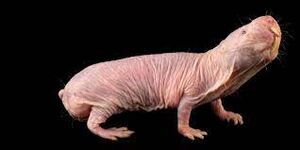Naked Mole-Rat
Naked mole-rats are small, fossorial rodents found mainly in Kenya and the Horn of Africa. They live in long, complex burrows and rarely venture aboveground. Their ability to thrive in the harsh conditions of subterranean Africa classifies them as extremophiles, and they have developed a number of unique traits seldom seen elsewhere in the animal kingdom. These include reduced pain sensitivity, cancer immunity, and eusociality. [1]

| |
| Kingdom | Animalia |
|---|---|
| Phylum | Chordata |
| Class | Mammalia |
| Order | Rodentia |
| Family | Bathyergidae |
| Genus | Heterocephalus |
| Species | Heterocephalus glaber |
Anatomy
Naked mole rats have very poor eyesight and hearing. Instead, these creatures rely mostly on their sense of touch to navigate their burrows and are especially sensitive to vibrations. True to their name, they lack fur on their bodies, which exposes their pale, wrinkled skin. However, they do have around 40 thin, whisker-like hairs on each side of their bodies that are sensitive to physical stimulation.
Besides their "naked" bodies, the other most striking part of the creature's anatomy are its large incisors. The jaw makes up about 25% of the creature's musculature, and it uses this muscle for a variety of tasks. The incisors are the primary tool used for digging their complex subterranean network of burrows. Additionally, they use their teeth as a transportation mechanism for food, debris, and their young.
[4]
Habitat and Distribution

Mole crickets live most of their life in the soil in burrows that average about 1/2 inch in diameter. [6] Various species of mole crickets can be found on every continent except Antarctica. They can be found in any location with moist, loose soil. [5] However, they show a preference for sandy soil. They can often be found within the vicinity of meadows and fields, specifically of corn and barley. [7] Mole crickets are rarely seen by people because of their underground habitat and nocturnal tendencies. [6]
Diet
The diet of different species of mole crickets can vary, but many will feed on both plant and animal matter. Mole crickets will build their burrows in order to suit their diets. Herbivorous species will construct shallow burrows to feed on roots and grasses, while primarily carnivorous species dig deeper burrows to search for prey. [8] The Tawny mole cricket and African mole cricket are examples of herbivorous species, while the Southern mole cricket is predominantly carnivorous. [9] Vegetable crops, worms, larvae, and insects are also food options for most species of mole cricket.[10] It is not uncommon for some species to attack others and engage in cannibalistic behaviors. [7]
Life Cycle

The life cycle of the mole cricket follows incomplete metamorphosis. Individuals grow from egg to nymph to adult. The life cycle of a mole cricket lasts from 1-3 years with about 1 generation of mole crickets being produced per year. [11] Mole crickets reach maturity in spring and early summer in the months of April and May. It is at this time that eggs are produced. Females deposit eggs into underground burrows between 5 and 30 centimeters deep. Females produce a mean of 4.8 egg clutches in their lifetime. Each egg cluster consists of 25 to 60 eggs and individuals spend 10 to 40 days in this stage. Nymphs resemble adult mole crickets but are smaller and lack developed wings. During the summer months, nymphs progress through approximately 8 to 10 stages of development. [10] Adult mole crickets have fully developed wings and specialized forelegs that allow them to dig extensive burrows and fly, typically at night.[12]
Mating & Reproduction
Male mole crickets attract females through stridulation from their underground burrows. Males produce their mating song for about 30 minutes to an hour an evening during their spring mating period. [13] Females selectively choose their mates based on factors like the intensity of the male mole cricket's song and the distance away the male mole cricket is. Larger males are often able to produce louder songs. Female mole crickets show a preference for nearby males because it requires less flying to reach them. While flying, female mole crickets are exposed to predators. The intensity of a male mole cricket's song may also reflect the soil conditions of their burrow. Greater soil moisture allows for better transmission of the male's song, which signals to females that their burrow would be a suitable location to lay eggs.[14] After the successful attraction of a female, male mole crickets seal off and abandon their burrow.[13]
Pest Control

Mole crickets have the ability to cause severe damage to soil and aboveground plant matter. They can sever plant roots, disrupt soil ecosystems, and consume crops. Their damage leads to aboveground patches of dead grass. Mole crickets are considered a pest and their spread through the world has resulted in many mole cricket species becoming invasive. They can be found in many locations including farms, pastures, golf courses, and backyards. The main method to eliminate mole crickets from an area has been pesticides. However, these pesticides have proven harmful to other organisms in the soil environment. Utilizing biocontrol organisms has been a more recent development in combatting mole crickets. One biological control organism used to target mole crickets is the Larra wasp which is a host-specific organism proven effective in reducing mole cricket numbers. [15]
References
- ↑ Holtze, Susanne, Alemayehu Lemma, and Stanton Braude. “The Microenvironment of Naked Mole-Rat Burrows in East Africa.” African journal of ecology 56 (2018): 279–89.
- ↑ Sartore, Joel. A Naked Mole Rat Photographed at Saint Louis Zoo in Missouri. Photograph. National Geographic. St. Louis. Accessed April 21, 2023. https://www.nationalgeographic.com/animals/mammals/facts/naked-mole-rat.
- ↑ “Heterocephalus glaber.” itis.gov, n.d. https://www.itis.gov/servlet/SingleRpt/SingleRpt?search_topic=TSN&search_value=584677#null.
- ↑ Browe, Brigitte M., Emily N. Vice, and Thomas J. Park. “Naked Mole‐Rats: Blind, Naked, and Feeling No Pain.” Anatomical Record 303 (2020): 77–88.
- ↑ 5.0 5.1 “Mole Cricket.” azanimals.com, 2021. https://a-z-animals.com/animals/mole-cricket/.
- ↑ 6.0 6.1 “Mole Cricket.” texasinsects.tamu.edu, n.d. http://texasinsects.tamu.edu/mole-cricket/.
- ↑ 7.0 7.1 Kidd, John. “On the Anatomy of the Mole-Cricket.” Philosophical Transactions of the Royal Society of London 115 (1825): 203–46. https://doi.org/10.1098/rstl.1825.0012.
- ↑ Li, Tongchuan, Ming’an Shao, Yuhua Jia, Xiaoxu Jia, and Laiming Huang. “Small-Scale Observation on the Effects of the Burrowing Activities of Mole Crickets on Soil Erosion and Hydrologic Processes.” Agriculture, Ecosystems. and Environment 261 (2018): 136–43. https://doi.org/10.1016/j.agee.2018.04.010.
- ↑ Cite error: Invalid
<ref>tag; no text was provided for refs namedunderground - ↑ 10.0 10.1 Capinera, John L, and Norman C Leppla. “Featured Creatures.” entnemdept.ufl.edu, 2001. https://entnemdept.ufl.edu/creatures/orn/turf/pest_mole_crickets.htm.
- ↑ 11.0 11.1 “Mole Cricket ID.” syngenturf.ae, n.d. https://www.syngentaturf.ae/mole-cricket-id.
- ↑ 12.0 12.1 Cite error: Invalid
<ref>tag; no text was provided for refs namedflorida" - ↑ 13.0 13.1 Hill, Peggy S.M. “Lekking in Gryllotalpa Major, the Prairie Mole Cricket (Insecta: Gryllotalpidae): Lek Mating in the Prairie Mole Cricket.” Ethology 105 (1995): 531–45. https://doi.org/https://doi.org/10.1046/j.1439-0310.1999.00417.x.
- ↑ Forrest, Timothy G. “Calling Songs and Mate Choice in Mole Crickets,” 1983, 185–204. https://doi.org/https://orthsoc.org/sina/g341lf83.pdf.
- ↑ “Mole Crickets.” sfyl.ifas.ufl.edu, 2021. https://sfyl.ifas.ufl.edu/lawn-and-garden/mole-crickets/.